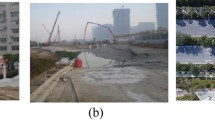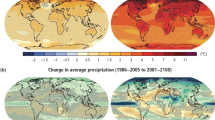Abstract
In this paper, the deformation response of the stratum in the vicinity of a tunnel is investigated based on a case study in Tian**. A method to predict the surface settlement in the case of double-track curvature shield tunneling is also proposed. The research methodology consists of analytical calculations, finite element analysis as well as field monitoring. Straight shield tunneling and curvature shield tunneling are modeled, each with a single-track shield and a double-track shield, and their operational parameters are compared. The influence of overcutting and existing tunnel on ground movement is also discussed. The salient observations from the series of analyses are as follows: (a) The maximum settlement induced by curvature shield tunneling is much greater than that induced by straight shield tunneling, while the existing tunnel has little impact on stratum settlement in contrast, (b) the proposed method of predicting the surface settlement induced by double-track curvature shield tunneling fits well with the field-monitored data in the Tian** case study, and (c) the location of the maximum ground settlement is deviated by the overcutting phenomenon, whereas the settlement of the soil above the excavated tunnel is reduced due to the presence of the existing tunnel.













Similar content being viewed by others
Data availability statement
All data generated or used during the study are available from the corresponding author by request.
References
Moeinossadat SR, Ahangari K (2019) Estimating maximum surface settlement due to EPBM tunneling by numerical-intelligent approach–a case study: Tehran subway line 7. Transp Geotech 18:92–102
Dias D, Kastner R (2013) Movements caused by the excavation of tunnels using face pressurized shields—analysis of monitoring and numerical modeling results. Eng Geol 152(1):17–25
Wang ZZ (2017) Study on tunnel characteristics of double shield tunneling with continuous curve of small curvature Radius. Master thesis, Tian** University, China.
Zhao C, Lavasan AA, Barciaga T, Zarev V, Datcheva M, Schanz T (2015) Model validation and calibration via back analysis for mechanized tunnel simulations – The Western Scheldt tunnel case. Comp Geotech 69:601–614
Zhang MJ, Li SH, Li PF (2020) Numerical analysis of ground displacement and segmental stress and influence of yaw excavation loadings for a curved shield tunnel. Comp Geotech 118:103325
Peck RB (1969) Deep excavations and tunneling in soft ground. In: Proceedings of the 7th International Conference on Soil Mechanics and Foundation Engineering, pp 225–290.
Zhu JF, Xu RQ, Liu GB (2014) Analytical prediction for tunnelling-induced ground movements in sands considering disturbance. Tunn Undergr Space Technol 41:165–217
Gue CY, Wilcock MJ, Alhaddad MM, Elshafie MZEB, Soga K, Mair RJ (2017) Tunnelling close beneath an existing tunnel in clay–perpendicular undercrossing. Géotechnique 67(9):795–807
Zhang P, Liu Y, Kang X, Zhong K, Chen R (2018) Application of horizontal MJS piles in tunneling beneath existing twin tunnels. In: Proceedings of the 2nd International Symposium on Asia Urban GeoEngineering, pp. 323–331.
Guo W, Wang G, Bao Y, Li P, Zhang M, Gong Q, Shen S (2019) Detection and monitoring of tunneling-induced riverbed deformation using GPS and BeiDou: a case study. Appl Sci 9(13):2759
Kim SH, Burd HJ, Milligan GWE (1998) Model testing of closely spaced tunnels in clay. Géotechnique 48(3):375–388
Li P, Du SJ, Ma XF, Yin ZY, Shen SL (2014) Centrifuge investigation into the effect of new shield tunnelling on an existing underlying large-diameter tunnel. Tunn Undergr Space Technol 42:59–66
Jiang B, Chen LA, Yang JS, Wang S, Ng CWW (2017) Effects of twin-tunnel excavation on an existing horseshoe-shaped tunnel considering the influence of a settlement joint. Can Geotech J 54(9):1346–1355
Migliazza M, Chiorboli M, Giani GP (2009) Comparison of analytical method, 3D finite element model with experimental subsidence measurements resulting from the extension of the Milan underground. Comp Geotech 36(1–2):113–124
Li XG, Chen XS (2012) Using grouting of shield tunneling to reduce settlements of overlying tunnels: case study in Shenzhen metro construction. J Constr Eng Manag 138(4):574–584
Avgerinos V (2014) Numerical investigation of tunnelling beneath existing tunnels. Ph.D. Thesis. Imperial College London.
Boonyarak T, Ng WWC (2014) Effects of construction sequence and cover depth on crossing-tunnel interaction. Can Geotech J 52(7):851–867
Zhang ZG, Huang MS (2014) Geotechnical influence on existing subway tunnels induced by multiline tunneling in Shanghai soft soil. Comp Geotech 56:121–132
Chen RP, Lin XT, Kang X, Zhong ZQ, Liu Y, Zhang P, Wu HN (2018) Deformation and stress characteristics of existing twin tunnels induced by close-distance EPBS under-crossing. Tunn Undergr Space Technol 82:468–481
Sigl O, Atzl G (1999) Design of bored tunnel linings for Singapore MRT North East Line C706. Tunn Undergr Space Technol 14(4):481–490
Kasper T, Meschke G (2006) On the influence of face pressure, grouting pressure and TBM design in soft ground tunnelling. Tunn Undergr Space Technol 21(2):160–171
Deng HS, Fu HL, Shi Y (2020) Calculation of surface settlement caused by excavation of shield tunnel with small turning radius. Chin J Geotech Eng 43(01):165–173
Mollon G, Dias D, Soubra AH (2013) Probabilistic analyses of tunneling-induced ground movements. Acta Geotech 8(2):181–199
Do NA, Dias D, Oreste P, Djeran-Maigre I (2014) Three-dimensional numerical simulation for mechanized tunnelling in soft ground: the influence of the joint pattern. Acta Geotech 9(4):673–694
Liu C, Zhang Z, Regueiro RA (2014) Pile and pile group response to tunnelling using a large diameter slurry shield – Case study in Shanghai. Comp Geotech 59:21–43
Zhou HZ, Hu QC, Yu XX, Zheng G, Liu XN, Xu HJ, Yang SC, Liu J, Tian K (2023) Quantitative bearing capacity assessment of strip footings adjacent to two-layered slopes considering spatial soil variability. Acta Geotech. https://doi.org/10.1007/s11440-023-01875-8
Chen XJ, Li DQ, Tang X, Liu Y (2021) A three-dimensional large-deformation random finite-element study of landslide runout considering spatially varying soil. Landslides 18:3149–3162
Lambrughi A, Rodríguez LM, Castellanza R (2012) Development and validation of a 3D numerical model for TBM-EPB mechanized excavations. Comp Geotech 40:97–113
Kavvadas M, Litsas D, Vazaios I, Fortsakis P (2017) Development of a 3D finite element model for shield EPB tunnelling. Tunn Undergr Space Technol 65:22–34
Zheng G, Lu P, Diao Y (2015) Advance speed-based parametric study of greenfield deformation induced by EPBM tunneling in soft ground. Comp Geotech 65:220–232
Hashimoto T, Ye GL, Nagaya J, Konda T, Ma XF (2008). Study on earth pressure acting upon shield tunnel lining in clayey and sandy grounds based on field monitoring. In: Geotechnical aspects of underground construction in soft ground, pp. 323–328.
Lai H, Zhao X, Kang Z, Chen R (2017) A new method for predicting ground settlement caused by twin-tunneling under-crossing an existing tunnel. Environ Earth Sci 76(21):1–12
Han X (2006) The analysis and prediction of tunnelling-induced building deformations. Ph.D. thesis, **’an University of Science and Technology, China.
Hu Y, Lei HY, Zheng G, Shi L, Zhang TQ, Shen ZC, Jia R (2022) Assessing the deformation response of double-track overlapped tunnels using numerical simulation and field monitoring. J Rock Mech Geotech Eng 14(2):436–447
Hu Y, Lei HY, Zheng G, Shi L, Zhang TQ, Shen ZC, Jia R (2022) Ground movement induced by triple stacked tunneling with different construction sequences. J Rock Mech Geotech Eng 14(5):1433–1446
Mair RJ, Taylor RN (1997) Bored tunnelling in the urban environment. In: Proceedings of the fourteenth international conference on soil mechanics and foundation engineering, pp 2353–2385.
Lee KM, Ji HW, Shen CK, Liu JH, Bai TH (1999) Ground response to the construction of Shanghai metro tunnel-line 2. Soils Found 39(3):113–134
Attewell PB, Farmer IW (1974) Ground deformations resulting from shield tunnelling in London clay. Can Geotech J 11(3):380–395
Loganathan N, Poulos HG (1998) Analytical prediction for tunneling-induced ground movements in clays. J Geotech Geoenviron Eng 9:846–856
Wei G (2009) Study on calculation for width parameter of surface settlement trough induced by shield tunnel. Ind Constr 39(12):74–79
O’Reilly MP, New BM (1982) Settlements above tunnels in the United Kingdom-their magnitude and prediction. In: Proceedings of Tunnelling 82: 173–181.
Rankin WJ (1988) Ground movement resulting from urban tunnelling: predictions and effects. Engineering geology of underground movements. In: Proceedings of the 23rd annual conference of the engineering, pp 79–92.
Knothe S (1957) Observations of surface movements under influence of mining and their theoretical interpretation. In: Proceedings of European Conference on Ground Movement, pp 210–218.
Mair RJ, Taylor RN, Bracegirdle A (1993) Subsurface settlement profiles above tunnels in clays. Geotechnique 43(2):315–320
Acknowledgements
The work described in this paper was financially supported by the Open Project of the State Key Laboratory of Disaster Reduction in Civil Engineering (Grant No. SLDRCE17-01), the National Key Research and Development Program of China (Grant No. 2017YFC0805402) and the National Natural Science Foundation of China (Grant No. 41630641 and 51808387). All of the support is greatly appreciated.
Author information
Authors and Affiliations
Corresponding authors
Additional information
Publisher's Note
Springer Nature remains neutral with regard to jurisdictional claims in published maps and institutional affiliations.
Rights and permissions
Springer Nature or its licensor (e.g. a society or other partner) holds exclusive rights to this article under a publishing agreement with the author(s) or other rightsholder(s); author self-archiving of the accepted manuscript version of this article is solely governed by the terms of such publishing agreement and applicable law.
About this article
Cite this article
Lei, H., Shi, L., Hu, Y. et al. Ground movement and settlement prediction induced by double-track curvature shield tunneling. Acta Geotech. (2024). https://doi.org/10.1007/s11440-023-02144-4
Received:
Accepted:
Published:
DOI: https://doi.org/10.1007/s11440-023-02144-4




